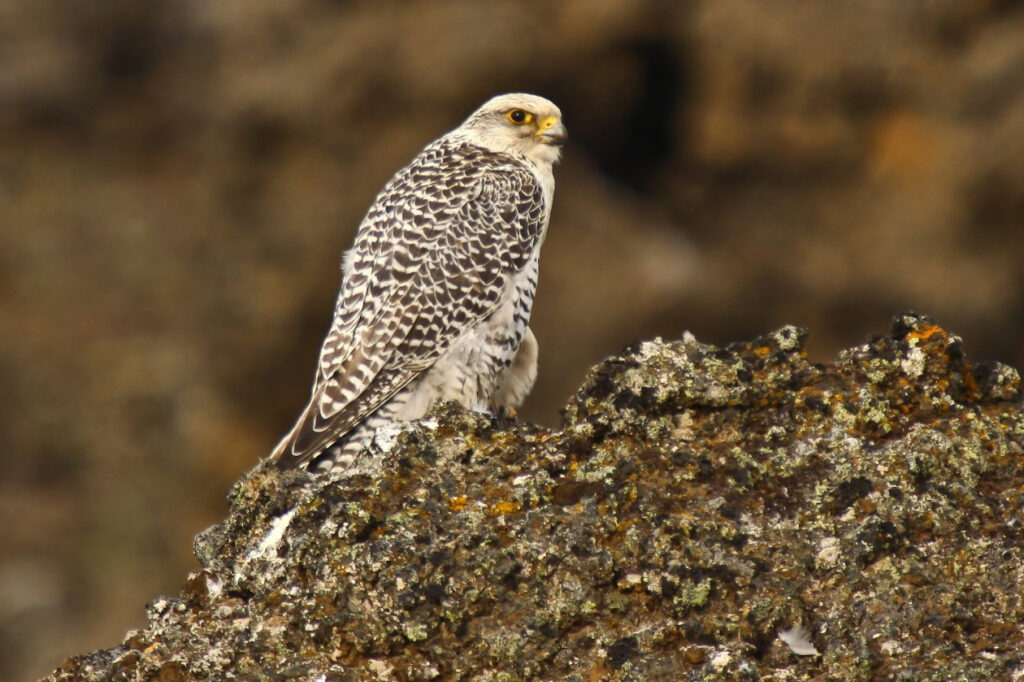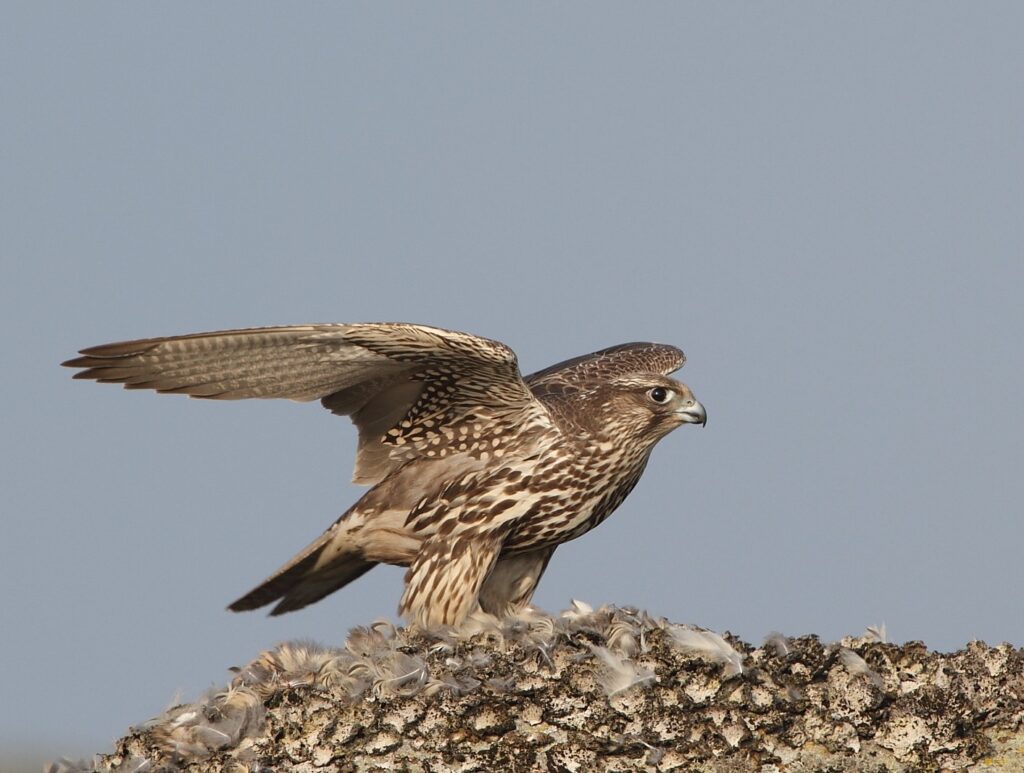Gyrfalcon
Originally published on 2018/04/15. Click here to return to the OneWordBirds Archives.
Well folks, it’s been a long time. Four-and-a-half months to be exact. It feels longer.
This winter has been chock full of challenges and while I will not bore you with all the details of my life, suffice it to say that writing has taken a backseat to other, more pressing concerns. And now here I sit at 9pm on a Saturday night, alone in my room and listening to the sounds of a raging mid-April ice storm1. I am of a mood, and as I so frequently do, I am turning to birds to free me from it.
But of my remaining one-word-birds, which is the right choice to alleviate the funk in which I currently sit? It’s tough to get amped up about a Dunnock or Palmchat, and I mostly certainly don’t have the ambition to figure out what the hell a Sapayoa or Hypocolius might be. No, what I need now is something easy and obvious. Something cool and charismatic. Something that’d get you out of bed in the morning. What I need now is a big friggin’ falcon.

Fortunately the one-word-birds list comes just so equipped, as on it resides the largest falcon species in the world: the Gyrfalcon. Be sure to pronounce that “jeer-falcon” to ensure others know that you know what you’re talking about. The prefix “gyr” may come from an old German world meaning “vulture” (apparently because of the bird’s size) or as I prefer, from a Latin word meaning “circle” in reference to the bird’s habit of circling in search of prey.
Before I begin to expound on this spectacular bird, I feel compelled to concede that I really like raptors. It pains me a little to do this because I feel that people who like raptors like them because they’re fast and strong and they kill things. Raptors appeal to macho men with barbed-wire tattoos and geeky 14-year-olds who collect throwing knives.
It would be much better, I think, to be the sort of self-assured person who derives joy from the subtle nuances of the sparrows, the fluting songs of the thrushes, or the delicate features of the hummingbirds. Or at least if one were drawn to the raptors, it would be preferable to appreciate their oft-muted colours or sophisticated aerial abilities. But mostly I like raptors because they’re fast and strong and they kill things, and that’s an unfortunate end of it.
I confess this to you because when I say that the Gyrfalcon is the most badass (the badassest? the baddest-ass?) of all the birds, you should know that I am aware of how that sounds. But facts are facts and that is one.
Naturally if I were to make such a brash statement in conversation, you would probably ask me to support my case. Well here goes. Firstly, the Gyrfalcon is a falcon, and as such it comes equipped with all the falcon kit. It is very agile and fast2, and it has a streamlined body with powerful feet, sharp talons and a sharp beak. But it is also bigger than all the other falcons and therefore better. Fact.
Secondly, the Gyrfalcon lives in one of the least hospitable landscapes in the world: the Arctic tundra. In the only-somewhat-freezing Arctic summer it scrapes a nest on a barren cliff ledge in which to raise its young. In the you’d-better-believe-it’s-freezing Arctic winter many Gyrfalcons forsake their luxurious cliffs and head for the frigid embrace of sea ice where they spend their time sitting on icebergs and hunting anything that moves.

Speaking of hunting, Gyrfalcons are really good at it, albeit not so picky about their target. Gyrs mostly hunt using a direct, horizontal pursuit or an angled dive3, and have been known to take all manner of songbirds, seabirds, waterfowl, grouse, ptarmigan, crows, ravens, hawks, owls, other falcons, rodents, hares, bats, and Arctic Fox. Whatever the prey, the Gyrfalcon typically kills it by striking it at great speed, then snapping its neck (if required). Like I said, badass.
Convinced yet? Need a little more? Well here you go. In the Arctic, food is scarce, so if you build a nest on the ground and put delicious and defenseless babies in it, all the other animals are going to want to eat them. For this reason the Gyrfalcon has earned a reputation for being particularly enthusiastic in defense of its nest, apparently dive-bombing and successfully deterring would-be predators such as owls, eagles, foxes, wolves, Wolverines and Grizzly Bears. Yes, Grizzly Bears.
Unfortunately seeing one of these formidable birds in the wild is no easy task. They are native to North America, Europe and Asia but unless you spend a lot of time in the land of the midnight sun you’re unlikely to stumble across one. Still, they are wide-ranging and prone to the occasional wander further south, so keep your eyes open and fingers crossed if you live in the northern half of the northern hemisphere.
It’s hard to imagine a bird with more street cred than the inimitable Gyrfalcon, and there’s little doubt that it deserves its spot on the one-word-bird list ten times over. Furthermore if you should happen to be feeling a bit down, it is somehow uplifting to know that such an incredible thing exists in this world. Unburdened by the trials and trivialities of human life the Gyrfalcon simply does its thing, and its thing happens to be freaking awesome. Birds to the rescue, as always.
1 Seriously, what is this garbage?
2 Gyrfalcons can exceed 200kph in their angled dives.
3 Not the drastic, vertical stooping of their famous cousins the Peregrine Falcons.
Photos:
Top and feature: By Ólafur Larsen – Fálki (Falco rusticolus) – Gyr Falcon Staðarheiti:, CC BY-SA 2.0, https://commons.wikimedia.org/w/index.php?curid=19921209
Bottom: By Marton Berntsen – Own work, CC BY-SA 4.0, https://commons.wikimedia.org/w/index.php?curid=38610649

